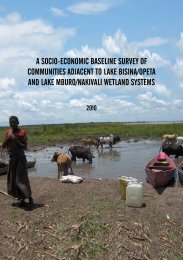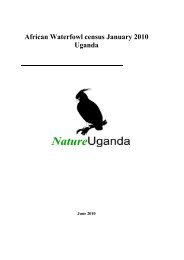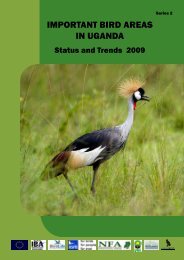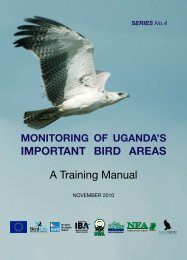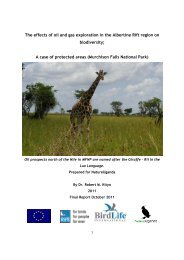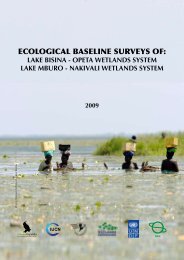the economic valuation of the proposed ... - Nature Uganda
the economic valuation of the proposed ... - Nature Uganda
the economic valuation of the proposed ... - Nature Uganda
Create successful ePaper yourself
Turn your PDF publications into a flip-book with our unique Google optimized e-Paper software.
for in <strong>the</strong> National Forestry and Tree Planting Act, <strong>the</strong> National Environment Act and provisions <strong>of</strong> <strong>the</strong> multilateral<br />
environmental agreements, especially <strong>the</strong> Convention on Biological Diversity. The compensation would also<br />
conform to <strong>the</strong> social and environmental safeguard policies <strong>of</strong> <strong>the</strong> Government <strong>of</strong> <strong>Uganda</strong> and its development<br />
partners, including <strong>the</strong> need to conduct a thorough environmental impact assessment (EIA). The appropriate level <strong>of</strong><br />
compensation <strong>the</strong> developer will be required to pay is US$45.1 million, payable to <strong>the</strong> NFA to support conservation<br />
activities in <strong>the</strong> remaining part <strong>of</strong> Mabira CFR and o<strong>the</strong>r reserves.<br />
The study also noted that Government could also waive <strong>the</strong> requirement for compensation. The study however,<br />
noted that such an action would tantamount to provision <strong>of</strong> a subsidy to SCOUL amounting to US$45.1 million or <strong>the</strong><br />
total <strong>economic</strong> value <strong>of</strong> <strong>the</strong> lost value <strong>of</strong> <strong>the</strong> forest due to <strong>the</strong> <strong>proposed</strong> change in land use. The waiver would also<br />
tantamount to a gross policy failure, particularly in view <strong>of</strong> <strong>the</strong> efficiency questions surrounding SCOUL.<br />
The study also noted that if <strong>the</strong> developer paid <strong>the</strong> US$45.1 million compensation, <strong>the</strong>y would in effect be purchasing<br />
7,186 ha <strong>of</strong> Mabira CFR at a fairly high cost per hectare. Land in <strong>the</strong> vicinity currently goes for UShs 500,000 to 1,000,000<br />
per acre (or Ushs 1,250,000 –2,500,000 per hectare). If SCOUL were to pay UShs 2,500,000 per hectare, double <strong>the</strong><br />
upper range, <strong>the</strong> company would purchase 30,668 ha <strong>of</strong> land. For <strong>the</strong> equivalent <strong>of</strong> 7,186 ha, if SCOUL purchased <strong>the</strong><br />
land from private sources <strong>the</strong> company would pay UShs.17,965 million (or US$10.6 million), an amount less than <strong>the</strong><br />
compensation figure calculated in <strong>the</strong> study.<br />
The study finally noted that in addition to <strong>the</strong> financial and <strong>economic</strong> questions presented above, o<strong>the</strong>r equally valid<br />
issues needed fur<strong>the</strong>r investigation. They include <strong>the</strong> need for compensation at ‘fair and equal’ value, <strong>the</strong> current<br />
implied objective <strong>of</strong> national self-sufficiency in sugar production; and land acquisition options available to <strong>the</strong><br />
developer.<br />
Viii The Economic Valuation <strong>of</strong> <strong>the</strong> Proposed Degazettement <strong>of</strong> Mabira CFR | 2011



